

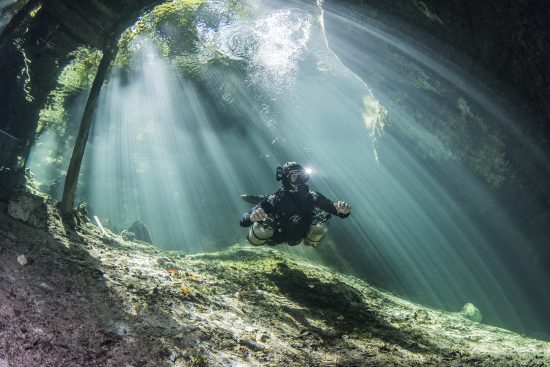
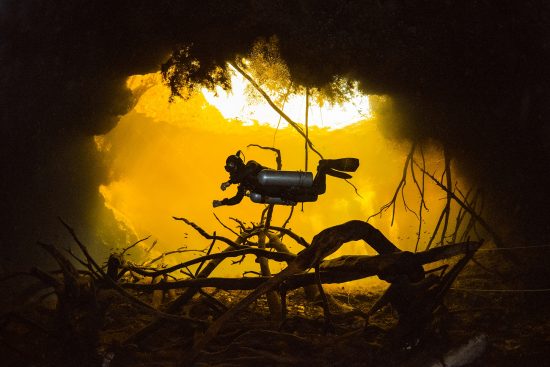
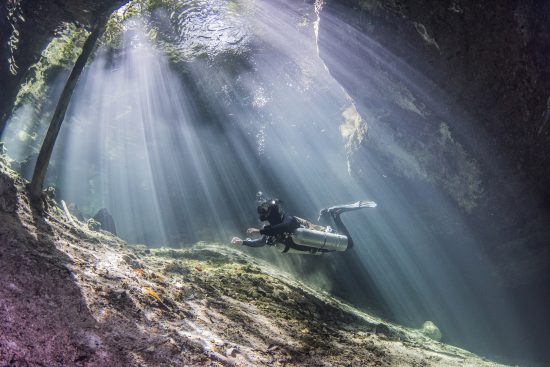
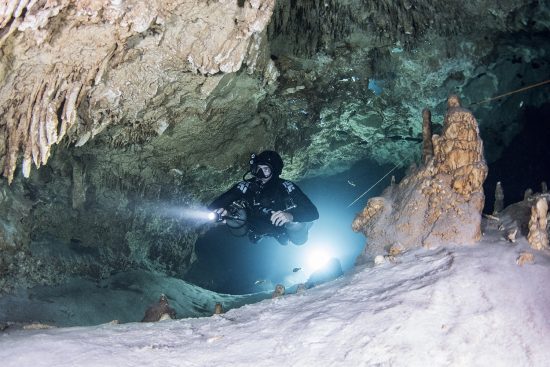
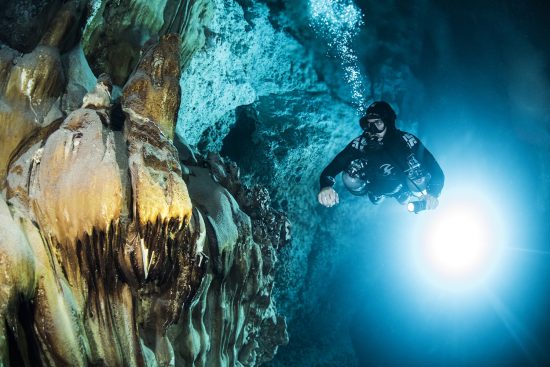
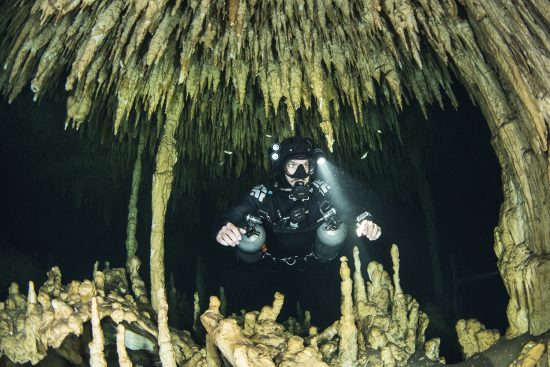


There are places on the planet where gods still dwell and there are other places where they used to dwell. This winter, we visited their abandoned dwellings, where the Maya worshipped and celebrated in ancient, mystical times when there were no divers like us.
We recently visited the huge, evergreen jungle of the Yucatan Peninsula in Mexico. There are many places in the jungle where you can enter the underworld of caves and tunnels. It is a special place, and we wonder how it is possible that nature was so imaginative and persevering as to fill this underground world with labyrinths and galleries and eventually flood everything. Because of this, this underground world was saved. Only divers can see it, experience it and try to describe it.
The rainy season lasts from May to October. Yucatan was once a great coral reef. During the past ice age, the ocean levels fell and the corals died. The jungle covered the old ridge and the rain slowly softened the soft coral limestone. When the ice age was over, the area turned into caves like a Swiss cheese. The water level rose and flooded the caves.
How do you access these underground caves?
On the Yucatan Peninsula, there are 6,000 entrances at points where the cave roofs have collapsed. These entrances are called ‘cenotes’.
The Maya believed that the cenotes were a sacred pathway to the gods; we know they even sacrificed humans in some as bones have been found. In only a couple of days we had the opportunity to dive in and get to know the El Pit, Dreamgate, Calavera, Dos Ojos, Angelita, Carwash, Tajma Ha and Casa cenotes.
As I looked over the dense jungle, with sunrays lost among the trees and lianas, I thought about the frozen subterranean areas that I would soon dive into, because scuba diving in caves is a special experience. Despite the fact that there is not much life (plants or animals) in these submerged caves, this is the best place to feel timeless. While on the surface, time passes by. When diving we observe fish and plants fluttering to the rhythm of life.
In these caves, everything is frozen as if in a huge crystal ball. Why?
The visibility in these caves is so good that we often ask ourselves - where is the water? Can we remove our masks? In addition to the crystal transparency of the water, the space contains walls, tunnels, vaults and shapes as if it were another planet. The long finger of the goddess that once lived there may have hollowed it out. Stalactites and stalagmites are constantly fighting for space, as if in some frozen war, and in all the cenotes we find prehistoric fossils that show that the caves were once a coral reef.
I look at the forest of branches at the bottom of the cave, growing from unreal clouds of gas. I feel the gas in my nostrils, though I have a mask. Sulphur vapours are a special surprise. These clouds of gas are green, yellow and white. Submerged underwater they form shapes like curtains or huge pillows.
There is a sudden change in salinity (Halocline - the border where sweet and salty water is mixed). It becomes obvious when suddenly the camera can no longer focus on anything and our eyes are betrayed. Everything becomes blurry, getting lost in the mist. In front of us, divers are disappearing, the light is breaking in different directions and the whole visible world disappears in rapid flashes.
The light I observed in the El Pit cenote during my dive the next morning made me think. How can I describe it? There are several ways. One of them would be that it were as if the cave had bitten off the hand of the Sun, not letting it in, wanting the darkness to be the guardian of the cave.
We approach with our torches to reveal the darkness that has kept this a mystery through millennia. In the darkness we feel something peculiar. It is not fear; it is a kind of awe. The vastness goes beyond our expectations and surpasses all limits of our knowledge. We become almost proud, honoured that we experienced this place, visited the darkness and illuminated it at least for a moment. This new experience changed us.
With my friends and hosts, Tom and Giulio, I took magnificent photographs from the bottom towards the light and inside the cave tunnels, and those images still follow me today because in some way they unite many of the locations I have dived or seen before.
The crystal clear water reminded me of iced lakes in Austria, with plants and the world from the surface penetrating the underwater world. The gas clouds reminded me of flying in an airplane above the clouds. The trees and branches look the same as when you are diving in a lake. The stalactites and stalagmites are like those in the Postojna or Biserujka caves, and the vast area of the underwater world looks very much like the Škocjan caves or some science fiction film.
Each of our dives was like an exploration of the universe. Perhaps that is how it looks when astronauts explore the underground tunnels of a new planet to study whether or not they are suitable for life. There was no other life to attract our attention, just the occasional fish, however you explore further because it attracts you, it is an incomprehensible labyrinth of new experiences.
Yucatan and the cenotes of Mexico, as a subterranean cave world, in some ways resemble the Cuban limestone caves called Mogotes in the Vinales Valley; a world of labyrinths that guarded ancient civilizations from extinction. In the end, they failed. The world has remained, but the civilizations are no more.
The jungle and its doors into the underworld attract millions of divers annually from all over the world. I hope that this was not our last encounter with the submerged, underground world of Mexico and that another expedition of our diving club “Roniti se mora” will experience the secrets of the ancient world still preserved in this place. The reason for this is not only the caves themselves, but also the Adventure Tour Center team that made us feel not only like friends, but like family.
What is interesting is that the owner Giulio is a guy who grew up and spent a good part of his youth on the streets of Zagreb. Besides Croatian, he speaks four other languages. Together with him, his team consists of Alberto and Tom, who did the lion's share of work in front of my lens. With the combination of the unimaginable beauty of nature and a top team, the fun and experience were unforgettable. Trust me when I say - we will see each other again!
 Damir
Damir 30th November 2018
30th November 2018 Tulum, Quintana Roo, Meksiko
Tulum, Quintana Roo, Meksiko 


